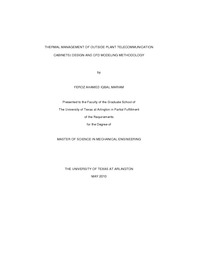
ATTENTION: The works hosted here are being migrated to a new repository that will consolidate resources, improve discoverability, and better show UTA's research impact on the global community. We will update authors as the migration progresses. Please see MavMatrix for more information.
Show simple item record
| dc.contributor.author | Iqbal Mariam, Feroz Ahamed | en_US |
| dc.date.accessioned | 2010-07-19T19:54:48Z | |
| dc.date.available | 2010-07-19T19:54:48Z | |
| dc.date.issued | 2010-07-19 | |
| dc.date.submitted | January 2010 | en_US |
| dc.identifier.other | DISS-10644 | en_US |
| dc.identifier.uri | http://hdl.handle.net/10106/4916 | |
| dc.description.abstract | Over the years there has been a steady increase in the number of transistors being packed into the same footprint of a die, which has led to an increase in the power densities of electronics. The thermal management of electronic equipment therefore is becoming an integral part of packaging design. Access networks provide the last mile of connectivity for the telecommunication network users. In the access network, the outside plant telecommunication cabinets houses electronic components and switching devices. These cabinets are standalone outdoor cabinets and many a times they are located in hostile environments. Therefore, it is necessary that these cabinets provide environmental protection and thermal management for the electronics housed in it. The first part of the thesis deals with the design and thermal analysis of air-cooled high powered telecommunication cabinets. Commercial CFD code has been used to design and compare various cabinet configurations. This has enabled in reducing the unnecessary construction of cabinet prototypes and elaborate experimental tests, resulting in cost savings and reduction in lead time. The electronics in these cabinets are powered by DC current and have backup batteries to support them in the event of a power failure. The life of a battery is dependent on the nature of the load applied, recharging conditions and most importantly ambient temperatures. Based on the location and time of day, the ambient temperature can be anywhere between -40°C to 50°C. But for long standing battery life, the temperature inside the battery compartment should be maintained at 25°C. Active cooling using air-conditioners are often used to achieve this, but air-conditioners are difficult to backup and are high in maintenance. A more convenient way to cool the battery compartments are to use Thermo-electric Coolers (TEC), as they are compact and quite in operation. The second part of the thesis explains a modeling methodology to develop a TEC air-to-air heat exchanger that is used in the thermal management of the battery compartments. The numerical results thus obtained are validated with experimental results, and the validated model is further used to try out various test scenarios for the telecommunication cabinet. | en_US |
| dc.description.sponsorship | Agonafer, Dereje | en_US |
| dc.language.iso | EN | en_US |
| dc.publisher | Mechanical Engineering | en_US |
| dc.title | Thermal Management Of Outside Plant Telecommunication Cabinets: Design And CFD Modeling Methodology | en_US |
| dc.type | M.S. | en_US |
| dc.contributor.committeeChair | Agonafer, Dereje | en_US |
| dc.degree.department | Mechanical Engineering | en_US |
| dc.degree.discipline | Mechanical Engineering | en_US |
| dc.degree.grantor | University of Texas at Arlington | en_US |
| dc.degree.level | masters | en_US |
| dc.degree.name | M.S. | en_US |
| dc.identifier.externalLink | https://www.uta.edu/ra/real/editprofile.php?onlyview=1&pid=4 | |
| dc.identifier.externalLinkDescription | Link to Research Profiles | |
Files in this item
- Name:
- IqbalMariam_uta_2502M_10644.pdf
- Size:
- 3.819Mb
- Format:
- PDF
This item appears in the following Collection(s)
Show simple item record


